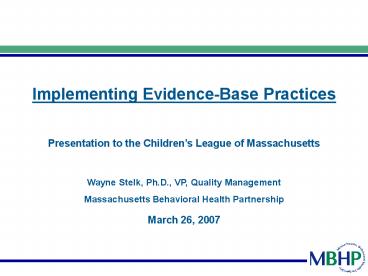Implementing Evidence-Base Practices - PowerPoint PPT Presentation
1 / 16
Title:
Implementing Evidence-Base Practices
Description:
Level I or Level II practice modified and applied to a different population or ... Positively related to rate of adoption (flies in the face of fidelity) ... – PowerPoint PPT presentation
Number of Views:48
Avg rating:3.0/5.0
Title: Implementing Evidence-Base Practices
1
Implementing Evidence-Base Practices
Presentation to the Childrens League of
Massachusetts
Wayne Stelk, Ph.D., VP, Quality
Management Massachusetts Behavioral Health
Partnership
March 26, 2007
2
The Evidence Hierarchy
- Randomized controlled studies
- Scientifically sound experimental studies
- Level I or Level II practice modified and applied
to a different population or in a different
setting - Sound research, with documentation of service
procedures and positive outcomes - Practice not research-based or replicable
3
Practice GuidelineLower Fidelity Demands
- Practice Guideline
- A clinical intervention typically developed
through a formal process, based on authoritative
consensus about the clinical literature - Intervention specifications are recommended, but
the specific application of the intervention for
the patient is at the discretion of the clinician
4
Evidence-Base PracticeHigher Fidelity Demands
- Clinical intervention based upon rigorous
research that shows positive outcomes
consistently in repeated research studies - The randomized clinical trial (RCT) is the gold
standard of evidence - As manualized treatment, clinicians must
strictly adhere to all clinical standards as
developed in the research protocol (fidelity)
5
Examples of EBPs
- 12-step treatment
- Behavior Therapy
- Brief Dynamic Therapy
- Brief Strategic Family Therapy (BSFT)
- Child and Family Team-Based Wraparound
- Cognitive Behavior Therapy (CBT)
- Community Reinforcement Approach (CRA)
- Contingency Management
- Dialectical Behavioral Therapy (DBT)
- Exposure-Based Procedures
- Functional Family Therapy (FFT)
- Hypnosis
- Intensive Group Therapy
- Interpersonal and Social Rhythm Therapy (IPSRT)
- Interpersonal Psychotherapy (IPT)
- Motivational Interviewing (MI)
- Multicomponent Cognitive Behavioral Treatments
- Multidimensional Treatment Foster Care
- Multisystemic Therapy (MST)
- Nurturing Parenting Programs
- Parent Management Training (PMT)
- Parent-Child Interactive Therapy (PCIT)
- Problem-Solving Skills Training (PSST)
- Program for Assertive Community Treatment (PACT)
- Psychoeducation
- Relaxation Exercises
- Social learning-token-economy programs
- Social Skills Training
6
What is a Treatment Effect?
7
Common Factors vs Disease Specific Effects
8
Clinician Characteristics/Effects(Mostly Ignored
in Research Design)
- Objective Characteristics
- Age, sex, ethnicity, socioeconomic background
- Cross-Situational Traits
- Personality and coping patterns emotional
well-being values, attitudes, beliefs cultural
attitudes - Therapy-Specific States
- Professional training therapeutic style choice
of treatment interventions - Clinician/Client Relationship
- Therapeutic alliance treatment expectations
- (Reference Wampold, 2001, p. 185)
9
What is Innovation Diffusion?
- Innovation
- An idea, practice, or object that is perceived as
new to the individual or organization - Diffusion
- The communication of an innovation through
certain channels over time among members of a
social system - Innovation creates UNCERTAINTY
- Diffusion strategies must overcome uncertainty
10
Crossing the Chasm
11
Factors Affecting Rates of Innovation Adoption
- The attributes of the innovation (EBP)
- (this factor explains 50 of the variance in the
rate of adoption) - Adopter (clinician) characteristics
- The communication channels (about which we dont
know much for clinicians) - The social culture and structure (agencies)
- Extent of change agents promotion efforts
12
Factors Affecting Rate of Adoption
- Relative advantage of the EBP
- Cost, status, incentives, mandates
- Compatibility (avoid empty vessel error)
- Adopter values, beliefs, needs, professional
training, indigenous knowledge - Complexity
- Negatively related to rate of adoption
- Triability
- Positively related to rate of adoption
- Observability
- The more observable the results, the better the
rate of adoption - Re-Invention
- Positively related to rate of adoption (flies in
the face of fidelity)
13
Stages in the Innovation-Decision
Process(compared to Porchaskas Stages-of-Change)
- Knowledge Stage (Precontemplation)
- Learn about requirements and necessary skills
- Persuasion Stage (Contemplation)
- Talk with others form positive image get peer
support - Decision Stage (Preparation)
- Seek additional information try it out
- Implementation Stage (Action)
- Use innovation a regular basis
- Confirmation Stage (Maintenance)
- Weigh advantages and benefits of continued use
14
What Are the Elements of a Good Implementation
Strategy?
- Know that good EBP products will not sell
themselves. - Simplistic EBP implementation plans are not
useful, such as Plan-Do-Check-Act. - Implementation of EBPs is a complex task
requiring - Empirically-based planning
- A good product
- A good understanding of the adopter-clinician
- Clinician characteristics
- Useful communication channels
- A good understanding of organizational readiness
for change - A medium for implementing the EBP (who is the
change agent?) and - Sufficient resources to build an EBP
infrastructure to sustain and evaluate the new
practices.
15
Implementation Options
- Disease-specific treatment
- Common factors approach
- Therapeutic alliance
- Feedback to clinician from outcomes evals
16
References
Mullen, E. J., Bacon, W. (2004). Implementation
of practice guidelines and evidence-based
treatment A survey of psychiatrists,
psychologists, and social workers. In A. Roberts
K. Yeager (Eds.), Evidence-Based Practice
Manual Research and Outcome Measures in Health
and human Services. New York Oxford University
Press. Rogers, E. (2003). Diffusion of
Innovations (5th ed.). New York Free
Press. Wampold, B. E. (2001). The Great
Psychotherapy Debate Models, Methods, Findings.
Mahway, NJ Lawrence Erlbaum Associates.































